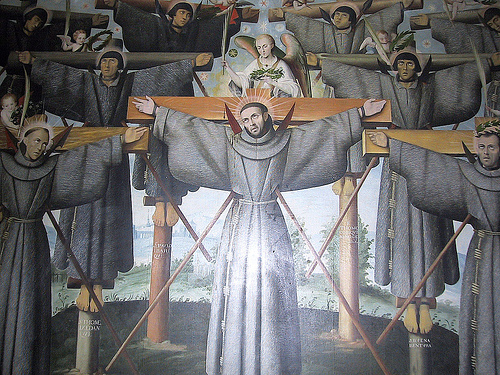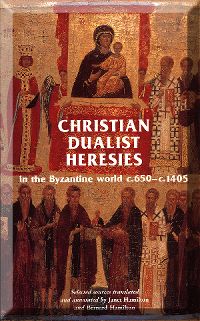CHRISTIAN HERESIES
Before looking at the Cathars and the Knights Templar it will be useful to see how the religious climate of Europe was anything but settled at the time. Indeed, the Roman Catholic Church was having to deal with more heresies than at any time since the Church Fathers had defined Christianity.
In its first four centuries the Christian religion was beset with heresies, several of which could very easily have become the dominant form of Christianity, and so might still have been with us today. (A heresy, after all, is only a belief that the current religious establishment wishes to crush.) One of these was Arianism which, if the Council of Nicaea had swung the other way in AD 325, would have saved generations of catechismal youngsters from wrestling with the complexities of Three-in-One and One-in-Three. As it is, Arianism has never entirely vanished, being with us today not only, in different ways, in the Unitarian movement and the Jehovah's Witnesses, but also, quietly, among the pews (and sometimes even in the pulpits) of many perfectly ordinary Anglican and Catholic parish churches. In its several varieties, Arianism basically said that if the Father was God, Jesus couldn't be. Or, to put it another way, there is only One Creator God.
Another heresy, Dynamic Monarchianism, held that Jesus was a normal man with divine power in him, a belief which, in one form or another, is quite widespread on the fringes of Christianity today.
One of the others, a very British heresy, was Pelagianism, founded by Pelagius, a fourth- to fifth-century Scots or Irish monk. Briefly, it taught that we can haul ourselves up by our own bootstraps; it is possible, albeit with a great deal of effort, to live a sinless life, and so to earn salvation. Even at the highest levels, the theological argument over salvation through faith versus works has never entirely gone away; while every day parish priests hear non-church-goers saying, 'But I try to lead a good life, Vicar; doesn't that count for anything with God?'
The next half millennium saw few new heresies, though it is worth noting that the ninth-century Irish scholar John Scotus Erigena taught that evil does not really exist, that individual reason is more important than authority, and that creation came from rays emanating from God.
But by the twelfth century, central Europe was awash with heretical teachings. In the early part of the century in southern France, for example, Peter de Bruys taught that Christians should disparage the cross rather than revering it, as it had been the means of torturing and killing Christ; this might well have been the source of the later allegation that the Knights Templar spat on the cross.
The Waldenses, founded by Peter Waldo around 1176, were in effect the first Protestants; they rejected everything about the Catholic Church that the Reformation would later also reject. They were condemned as heretics and persecuted, and many were burned by the Inquisition; but they have survived to the present day.
Meanwhile the Manichaeans lingered on around the Mediterranean. Manichaeism had an offshoot, the Paulicians, though some authorities see the latter as an independently-arising movement with similar beliefs because of their common Gnostic inspiration. The Paulicians may have been in existence as early as the fourth century, but they became prominent when they moved to Armenia in the mid-seventh century. Opposed to the theological complexity, the idolatry and the wealth of the Catholic Church, they reached their height in the ninth century, when they actually founded their own short-lived state in the Balkans.
They in turn seem to have inspired the Bogomils, or Friends of God, founded (at least in legend) by a tenth-century Eastern Orthodox priest, Bogomil. He taught the Gnostic dualist belief that the world was created by an evil being, not by God, and that Christ had come to free people from the Devil's hold. (Later they saw this being, Satanaei or Satan, as Christ's elder brother; Mormons today believe that Lucifer was Christ's brother.) Bogomil also preached a social gospel to the oppressed peasants of newly-feudal Bulgaria: the nobles and priests were the Devil's servants. Despite the Catholic Church's opposition and persecution (an eleventh- to twelfth-century Bogomil monk, Basil, was burned to death) the religion took hold, eventually becoming the state religion in Bosnia and Hungary, and also very strong in Serbia. |
|
The Bogomils lasted until the fourteenth century, when the Balkans were invaded by Muslims, and many Bogomils converted to Islam.
In their heyday, however, the influence of the Bogomils extended as far as Italy and France. Their priests and monks were called perfecti; stressing purity of spirit they ate no meat and abstained from sex, both being seen as part of the evil material world. Although most Bogomils lived ordinary lives, they often took the consolamentum, a ceremony which purified them, shortly before death.
The better-known Cathars, who will be discussed shortly, did not suddenly spring out of nowhere.
One of the commonest charges against heretics was sodomy. The Cathars and the Knights Templar, among others, were accused of this; so were the Bogomils, who came from Bulgaria, and so were referred to by the French as bougres (Bulgars), giving us the English word 'bugger'. Sodomy, said the Catholic Church, was how Bogomils and Cathars had sex without bringing more babies into the world.
Although the Beguines and the Brethren of the Free Spirit came into existence after the Cathars began, discussion of them still helps to illustrate the variety and complexity of the religious situation in Europe in the late Middle Ages.
The Beguines, a largely female grassroots religious movement in western and central Europe from c. AD 1200, are thought by some to have taken their name from the Albigensians (Cathars), though there was no overlap in beliefs. Some lived in communities, while many others travelled from place to place. Although initially unsanctioned by the Church, they took a vow of chastity, seeing themselves as a religious Order. They worked in the community, caring for the sick and supporting themselves by their crafts and by begging. From the start their independence and their emphasis on the virtues of poverty irritated the Church.
In southern Europe, male followers were called Beguines; in northern Europe they were called Beghards.
As the movement developed, some Beguines moved towards mysticism, and some took on heretical beliefs, studying and preserving the works of the twelfth-century French philosopher Amalric of Bena, whose teachings were a development of those of John Scotus Erigena: the world emanated from God, and God is in everything. Other Beghards and Beguines became Brothers and Sisters of the Free Spirit; they believed that as the Holy Spirit indwelt them, they were completely pure, and to the pure, all things are pure (Titus 1:15). Although there is little evidence (beyond accusations by the Inquisition) that they behaved licentiously, they believed, at least in theory, that they were above the law, whether moral, religious or state. Those who were sanctified could no longer sin.
Sin is the will to offend God, and he whose will has become God's will cannot offend God. His will is God's will, and God's will is his will. A man may become so completely Divine that his very body is sanctified, and then what it does is a Divine act. In this state the instincts and impulses of the body take on a holy significance. This extreme belief still exists; I once heard a Pentecostal preacher say, 'God came into my heart in 1956. Since that day I have not sinned.' No doubt that preacher would be horrified at the logical comparison with Aleister Crowley's famous dictum, 'Do what thou wilt shall be the whole of the Law'.
Beyond sin or not, the Brethren of the Free Spirit saw no need to obey the Church, or to receive the sacraments from priests. They also believed that there was no hell, and that all would be saved, the latter a doctrine to resurface later in America with the late eighteenth-century Universalists, now merged with the Unitarian Church there.
The Brethren of the Free Spirit, inevitably bringing the Church's persecution on themselves, brought it also on many other Beguines whose beliefs were more orthodox. By now the Church, through practice with the Cathars, met any suspicion of heresy with torture and death.
More
 |




